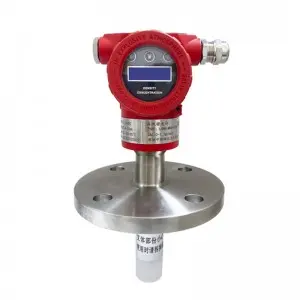Fermentation monitoring and process control mean creating perfect growing and fermentation environment for microbial, Then keep a stable efficiency, yield and consistent product quality. Key parameters like pH, dissolved oxygen, temperature, substrate concentrations, viscosity are all factors determines quality and efficiency in pharmaceutical factories, in which rigorous requirements are put forward for process line.

Necessities of Fermentation Broth Viscosity & Concentration Monitoring
Both concentration and viscosity serve as a dynamic indicator of microbial growth, cell density, and broth composition, profoundly influencing critical factors such as mass transfer, oxygen availability, and nutrient distribution. Without meticulous fermentation monitoring and process control, fluctuations in concentration and viscosity can disrupt the delicate balance of the fermentation environment, leading to diminished yields, inconsistent product quality, and costly inefficiencies.
Continuous online monitoring of the fermentation process delivers real-time data, empowering operators to make swift, precise adjustments to parameters like nutrient feed rates and aeration levels. Eliminate negative effects brought by delayed and time-consuming manual sampling.
Overview of the Penicillium Fermentation Process
Pharmaceutical fermentation is a sophisticated project of microbiology and engineering, where carefully cultivated microorganisms, such as bacteria or fungi, produce vital bioproducts like antibiotics, vaccines, and enzymes.
The Penicillium fermentation process starts from inoculum preparation in seed tanks. Then shift to fed-batch fermentation in nutrient-enriched media within large deep-tank fermentors, including downstream equipment for recovery and purification. Fermentation broth concentration and viscosity are continuously monitored and regulated using inline process sensors, internal model controllers, and automated systems to enhance yield and prevent contamination.

Properties of Penicillium Chrysogenum in Batch Fermentation for Penicillin Production
Penicillium chrysogenum, a filamentous fungus, is the microorganism of choice for the industrial production of penicillin. Its behavior during the fermentation process is highly complex and directly impacts the efficiency and yield of the final product. Understanding its properties is essential for effective process control.
During fermentation, viscosity and concentration are closely linked, and changes in one directly affect the other. This relationship is a critical aspect of process control, as it impacts everything from microbial growth to product yield.
Viscosity Changes
The viscosity of a fermentation broth is a measure of its resistance to flow. It's not constant and typically changes throughout the fermentation cycle due to several factors:
Concentration of microorganisms increases with their growth and multiply in biomass growth. Just the physical presence creates a dense, intertwined network of cells, which raises the viscosity of fermentation broth significantly.
Cell lysis occurs at the end of fermentation. Microbes may lyse if the cells are stressed, releasing intracellular components like DNA and proteins. These large molecules can also significantly increase the broth's viscosity.
Concentration Changes
Concentration fluctuates with bacteria multiplying as the cell density caused crowded broth and more frequent interactions between cells. Of course, the initial concentration of substrates like sugars and nutrients have an obvious effect on further growth of microbial.
Secreted protein and polysaccharide accumulate in continuous fermentation, contributing to concentration increasing of dissolved or suspended solids.

The Impact of the Relationship
The close relationship between viscosity and concentration has major implications for the fermentation process. A rise in viscosity due to increased concentration can:
Hinder Mass Transfer: High viscosity makes it harder to transfer essential gases like oxygen from the air bubbles into the broth, limiting the microbes' ability to grow.
Decrease Mixing Efficiency: A thicker broth requires more energy to mix effectively. This can lead to stagnant zones where nutrients are depleted and waste products accumulate, creating an uneven environment that negatively affects productivity.
Affect Downstream Processing: Highly viscous broths are more difficult to filter, centrifuge, and purify during the product recovery phase, making the entire process less efficient and more costly.
Therefore, monitoring viscosity and concentration in real-time is crucial for maintaining optimal conditions, ensuring consistent product quality, and maximizing yield.
Applications of Inline Viscosity Monitoring
The transformative potential of online monitoring in the fermentation process is particularly evident in antibiotic production, such as penicillin. Real-time viscosity tracking allows operators to gauge microbial growth and broth consistency, enabling precise adjustments to feeding strategies, aeration, and agitation.
Automated process technologies act as an alertor before potential anomalies, contamination, foam formation to prevent production accidents. Moreover, it enables scalability from lab to industrial bioreactors.
Lonnmeter Inline Viscosity Measurement Solutions
Main Functions and Technical Specifications
The inline sanitary viscometer and pharmaceutical density meter are designed for fermentation monitoring and process control in pharmaceutical applications. Their special mechanical design reduces possibilities of bacterial buildup, regular maintenance and even replacement.
These inline automation instruments provide real-time viscosity and density measurements, ensuring consistent broth conditions in bioreactors. The inline sanitary viscometer features a with viscosity range 10–10000,000 cP. It’s temperature tolerance reaches 350°C.
Equipped with advanced vibrational or resonance-based sensors, these instruments deliver precise readings in dynamic conditions and integrate seamlessly with PLC and DCS systems for automated control, making them ideal for the fermentation process of penicillin.
Advantages Over Traditional Offline Methods
Lonnmeter’s inline viscosity measurement instruments outshine traditional offline methods. Advanced process automation tools enable immediate process adjustments, eliminating sampling errors.
Their precision in handling non-Newtonian broths surpasses offline tools, which often falter with complex fluids. The sanitary design minimizes contamination risks, critical in pharmaceutical settings, while automated data collection reduces human error, ensuring superior reliability for online monitoring of the fermentation process.
Benefits in Fermentation Process Automation
Lonnmeter’s solutions transform automation in the continuous fermentation of penicillin, delivering unmatched benefits. They ensure consistent fermentation broth viscosity, resulting in uniform penicillin yields and high purity.
Automated viscosity control reduces waste, energy consumption, and downtime, driving significant cost savings. Real-time data enables fine-tuning of feed rates, aeration, and agitation, optimizing process efficiency.
The critical importance of inline viscosity monitoring in pharmaceutical fermentation, particularly for the penicillin fermentation process, cannot be overstated. Take your fermentation process to the next level—contact Lonnmeter today to request a personalized quote for our advanced viscosity measurement solutions and unlock unparalleled production precision!
Post time: Aug-14-2025












